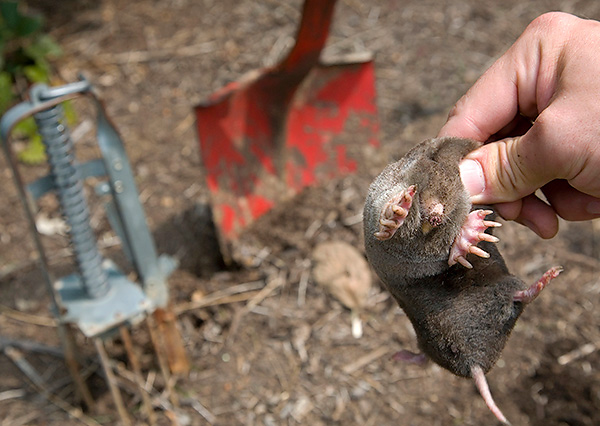
Next you will learn:
- What effective and time-tested methods exist to catch a mole in the garden by doing this quickly enough and without significant financial costs;
- The principle of operation of the mole-tube-pipe and what design options for this trap really give the desired result;
- How can you easily catch a mole in a bucket or in an ordinary glass jar;
- What is important to know about the proper installation of traps on the site, so that their efficiency is as high as possible;
- What to do with a mole after it is caught;
- What traps and traps of lethal and crippling action are the most popular and does it really make sense to use them (including fishing hooks);
- How can you reliably protect your garden from the re-entry of moles.
In general, trapping moles can be considered a much more effective way of combating these pests in the garden than using all kinds of deterrents, including sound and ultrasonic repellers of various designs.
First of all, if you catch a mole, then the situation typical for cases of using repellers, when the mole simply moves to the other end of the garden and digs there (or temporarily leaves for the neighboring area), will definitely not arise. In addition, by correctly applying molehills, sometimes it is possible in the literal sense of the word to practically reduce to zero the number of mole populations, not only in their area, but in general in the territories adjacent to it.

On a note
An important point is that the capture of moles is a humane way of combating these pests - compared, for example, with methods such as using poisons, pumping car exhaust into underground passages or flooding them with water. When a civilized man catches a beast in a live-trap, he saves his life and does not cripple, but simply releases him far from his garden.
Of course, this is true for situations when the gardener is originally going to catch a mole and not kill him at the same time. However, today there are live-fishing methods of fishing, in the implementation of which moles are crippled and then long tormented by imminent death. Some of these barbaric methods of catching moles in a garden plot will be mentioned below.
Now let's see with what devices you can quickly catch all the moles in your area and how to effectively apply the appropriate designs in practice.
All ways to catch a mole
Generally speaking, today the following popular methods of catching moles in the garden and country house are most widely used:
- The so-called mole head pipe, into which the mole creeps, but can already get out;

- A pit trap into which the animal simply falls, moving along its underground passage, and then can no longer get out of it;

- Traps that kill animals immediately or slowly (the wire mole catcher also applies here);

- Tackle from fishing line and fishing hooks: the mole clings to the hook either with its skin (skin), running up the tunnel or with its mouth, collecting earthworms strung on fishing hooks (and this is just one example of a flies approach to catching moles);

- Perhaps, one should also mention the usual shovel - with the proper dexterity and experience, with its help it is possible to dig a small animal out of the ground alive, and then, for example, put it in a bucket.

It is noteworthy that the efficiency and ease of use of all these options are approximately the same (with the exception of shovel fishing - this method is the least effective and requires a considerable investment of time).Any trap is simply installed in the garden, catches the mole in one way or another, and the gardener can only from time to time check the presence of the "catch".
Accordingly, the question arises: if a live trap catches a mole as simply and quickly as a mechanism piercing a little animal with a spoke or breaking a ridge to it, then why use lethal traps in general? Unfortunately, in many cases the answer lies in the banal laziness of the gardener - it’s just too lazy to take out the caught moles each kilometer from the site, because it’s much easier when the trap “delivers” a ready-made corpse that can be easily disposed of, for example, by digging it in the far corner of the garden.
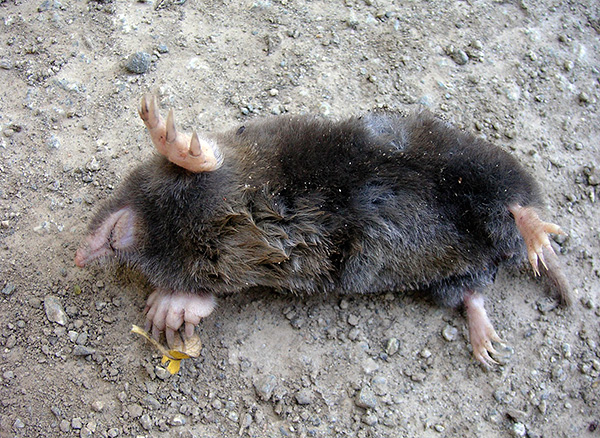
On a note
Some gardeners justify their actions to destroy moles in the following interesting way: they say, in the wild it is customary to protect your site from the encroachments of strangers. Well, they say, I also protect the results of my work (beds, crops) from the attacks of the pest, I protect my territory.
Well, that’s right - in the world of animals this is how it is. The question is, why compare yourself with an animal ...
Kotolovolki-pipes bought and made by hand
The classic trap for a mole in the form of a pipe has a rather simple design: it is a plastic or metal pipe with a diameter of about 9-12 cm (average diameter of the mole's stroke), with doors on both sides on the upper hinges. The doors of the mootole head pipe easily open inward, but do not open outward.
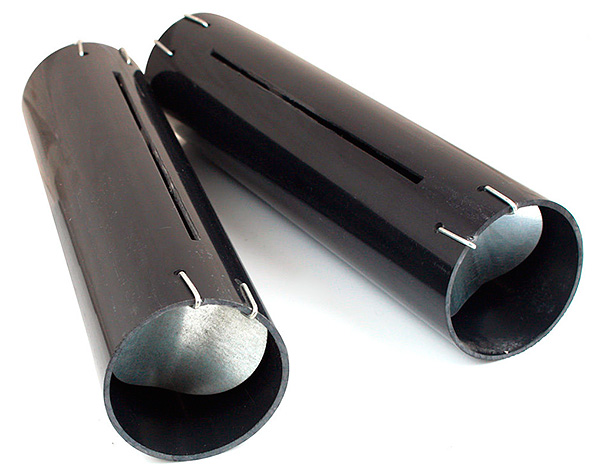
A mole trap made by this principle is called the Solomon trap.
In order to catch a mole, a pipe trap must be installed in the excavated course of the animal. The mole, moving along the tunnel, stumbles upon a door, pushes it forward and crawls into the trap. The door under its weight falls down, and the animal can no longer open it from the inside.
If the second mole moves the second one, then he, too, will crawl into the trap and remain in it, and the animals can climb into the live trap from different sides.
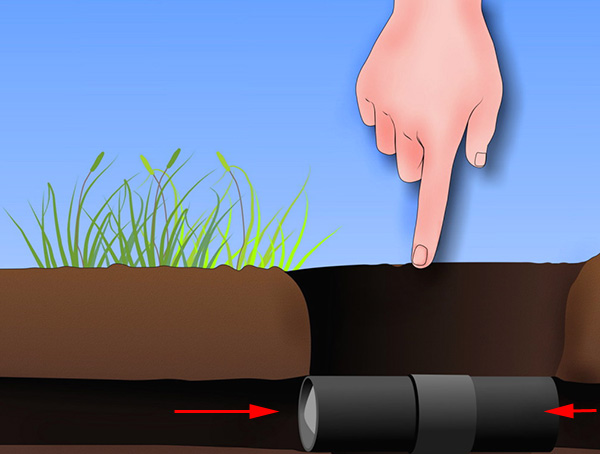
On a note
There are cases when, when checking in one livestock, up to 3 moles were detected at once. Sometimes, together with a mole, shrews simultaneously fall into a pipe trap. During the day, some gardeners managed to trap 6 moles with such a trap.
Krotolovka-pipe can be made with your own hands from improvised materials. In a piece of pipe, you need to make only light hinges for the doors, and also provide a stopper to open the door out. The easiest way is to make the door itself of a greater height than the passage of the pipe (in fact, an oval shape), and hang it on a hinge obliquely inward.
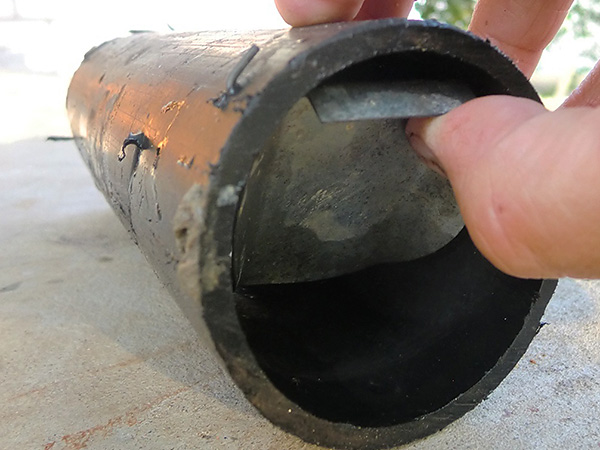
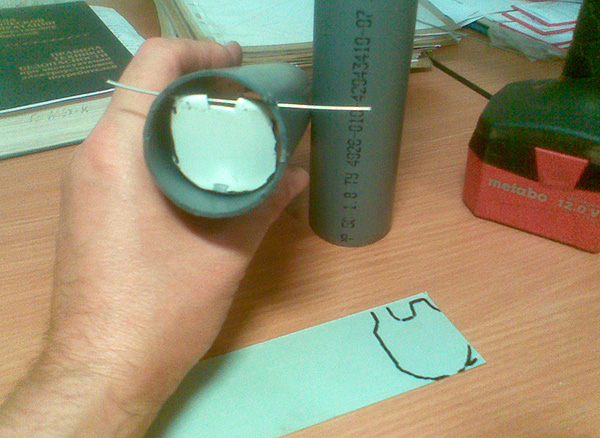
Options for such traps available for sale cost about 200-400 rubles.
In the West, special plastic molehills are made, from which you can get animals without digging the trap itself. The photo below shows an example of such a device:
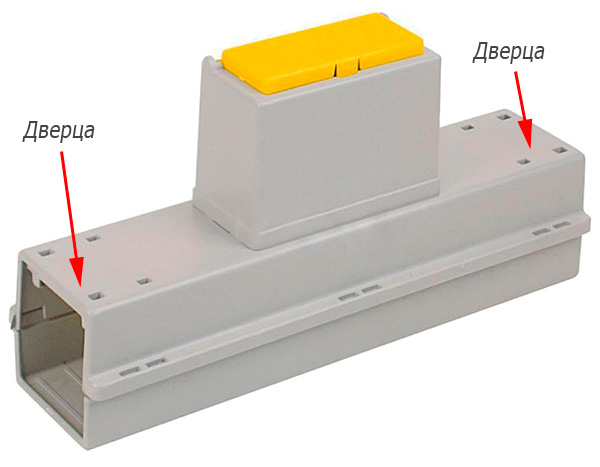
Another version of the trap that works on the same principle is a design of several plastic bottles inserted one by one with the necks. The necks of the bottles are cut with scissors in several places to make easily extendable petals. The mole, crawling into such a “neck”, weighs the petals inward with the weight of its body, penetrates the central section of the trap, and then it can no longer open the plastic petals to crawl out.
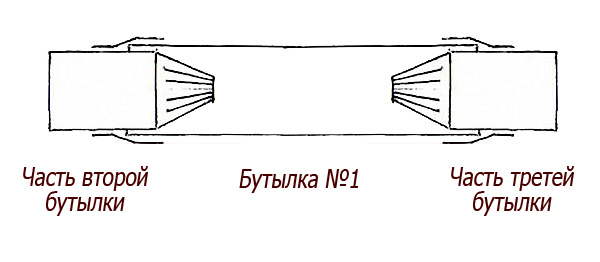
Such a mole trap made of plastic bottles is exclusively a product of folk art. It is easy to do it yourself, having at hand three bottles of the same size, scissors and scotch tape.
Mole trap-pit, or how to catch a mole in a bucket
Such a trap is also made from improvised materials. The main task here is to make a hole in the middle of the mole, in which the animal will fall and will no longer be able to get out of it.
Usually, in order to catch a mole in this way, they use a deep pan, bucket (plastic or metal), a glass jar or a cut-off plastic bottle of large diameter.
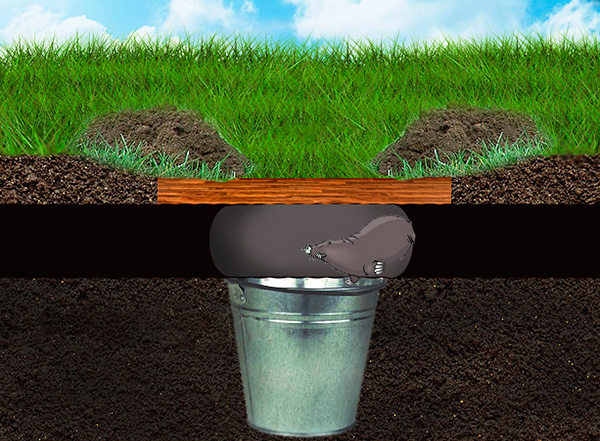
A molehill-pit is formed under the course of the animal in such a way that its upper edge is at the same level with the lower edge of the underground passage. From above, the entire "excavation site" is covered with a sheet of plywood or other opaque material (so that the mole does not deter sunlight). As a result, the animal, just moving along the way, falls into the installed capacity.
The photos below show how to install a regular three-liter jar for this:
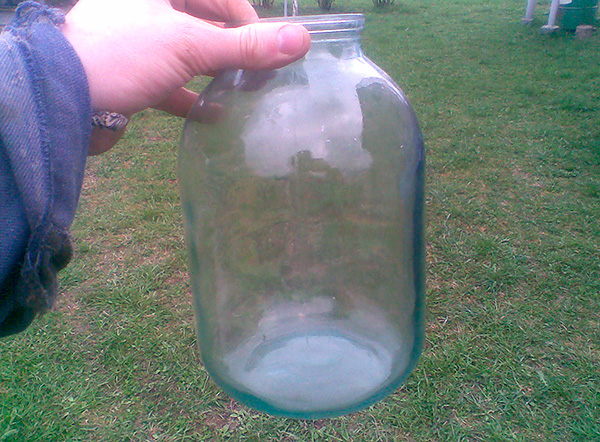
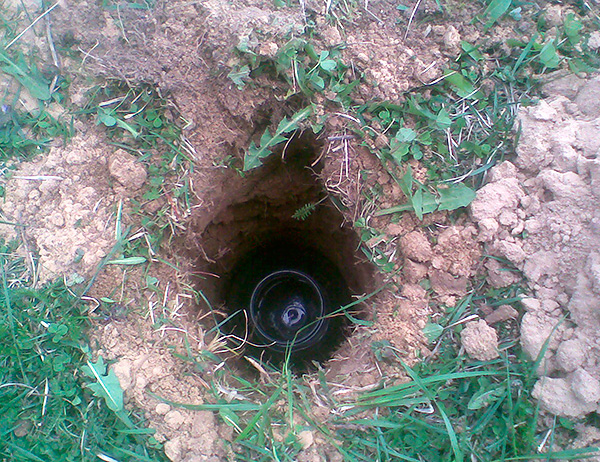
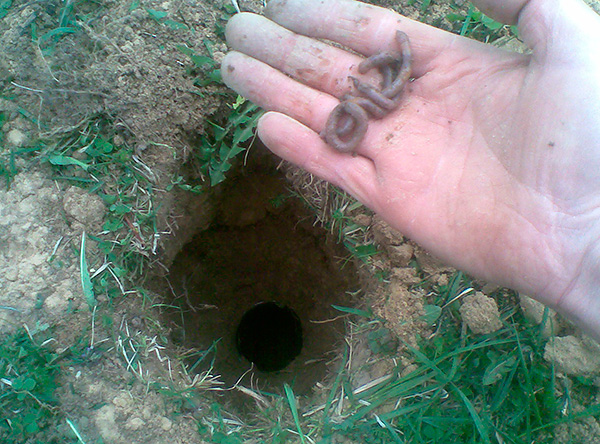
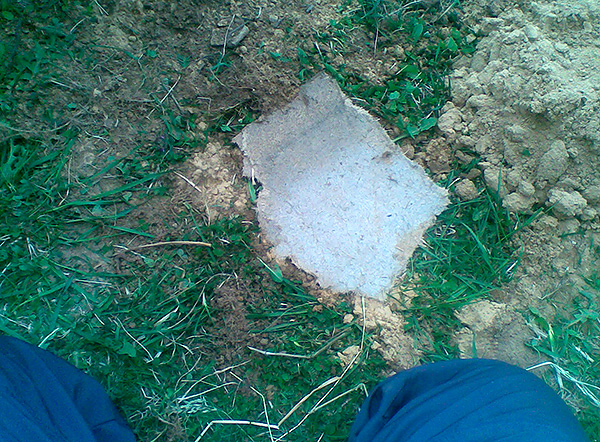
Such live-traps are as simple as possible to manufacture and do not require financial investments. Often a couple of these traps allows you to catch not only all the moles in your garden, but also shrews, field voles and other animals.
On a note
If a mole and a shrew fall into a trap-pit at the same time, then, as practice shows, with a high probability a shrew will soon become a food source for a mole.
How to set traps correctly?
In order to quickly catch a mole in a summer cottage or garden plot using a trap, when installing it, you need to follow a few simple rules, ignoring which can significantly reduce the chances of success.
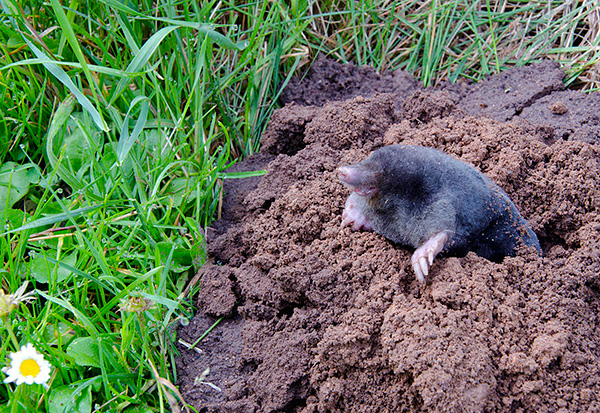
These are the rules:
- The molehill must be installed in horizontal near-surface passages between molehills (preferably fresh). Almost never manages to catch a mole, if you set a trap in the very heap of discarded land;
- When excavating a course, as little damage as possible should be created. It is advisable to work as a garden scoop rather than a shovel;
- Having made a hole, you should try to restore the adjacent sections of the mole's course, as far as possible. It is desirable to lay out the edges of the trap itself with the earth, slightly pressing it flush with the walls of the container;
- The trap installation site must be covered on top with absolutely opaque material, and sprinkled with earth at the edges (practice shows that even the smallest gap that allows sunlight to penetrate the pit greatly reduces the effectiveness of the trap - moles, although they have poor eyesight, however, they are able to distinguish light from darkness well);
- If you want to increase the efficiency of the mole catcher-pipe or pit, then it is recommended to put several earthworms cut into pieces inside the trap - it attracts moles from the smell (these animals feed mainly on earthworms).
An important point - after installation, the trap must be checked every 5-6 hours. The fact is that moles, due to a very fast metabolism, die of hunger in the absence of a food source for about 18-24 hours. So a day without food for a caught mole is certain death, and any “live-trap” without proper supervision can easily become a torture chamber, guaranteeing the animal a slow, painful death.
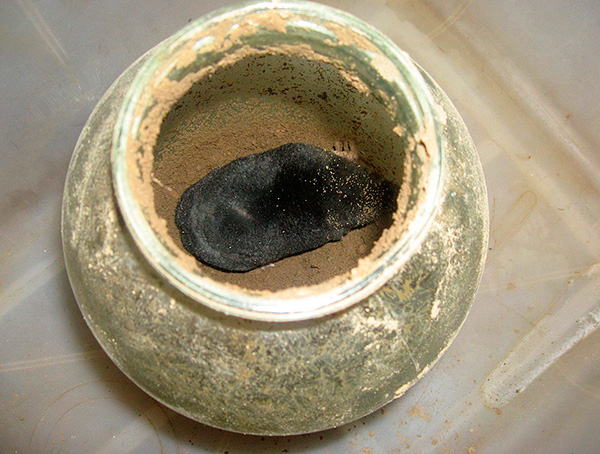
Considering that after extraction from the trap and removal from the site, it will take some more time until the mole can catch the first prey, it is advisable to keep it caught in the mole trap no more than 6 hours.
On a note
Some of the commercially available mole-tube pipes have special openings through which you can see whether the mole is trapped or not, without digging the entire structure out of the ground each time. Therefore, in the manufacture of a makeshift trap from a pipe, it is advisable to foresee similar viewing holes in advance (see the example in the photo below).
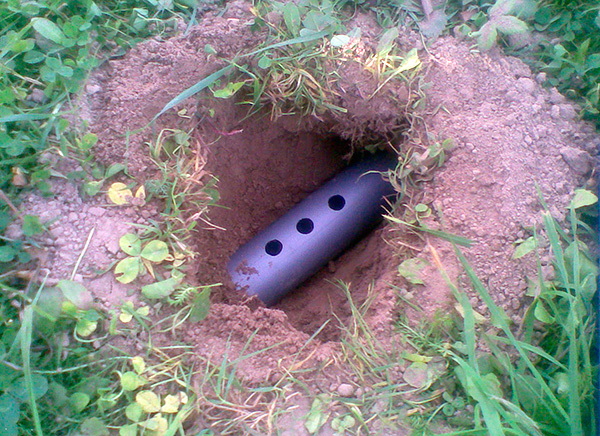
What to do with a mole after capture?
Immediately after the mole is caught, it is necessary to remove it from the trap - before that it is advisable to put on tight construction gloves, since the animal has sharp teeth and can bite painfully.
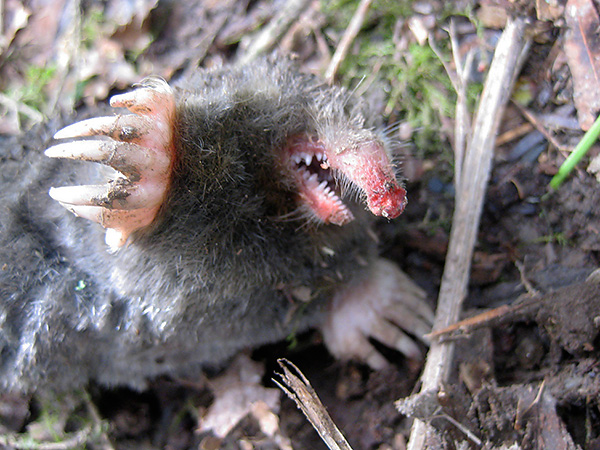
The caught mole can be planted in any high capacity (for example, in a bucket) and taken out of the site at a distance of at least 1 km from its dacha.It is this distance that ensures that this individual will never return to your site again (in the worst case, after several seasons, the descendants of this mole may wander to you).
It is preferable to release the animal either in a field with loose earth, where it can quickly dig into the ground, or in a bush, where it is least visible to predators (mainly to birds of prey). On this, the task of capturing a mole can be considered solved: the garden is spared the pest, the animal itself is not destroyed, not crippled and released into the wild, where it has a high chance of survival.
On a note
Do not be afraid that you will have to make moles from the garden 20-30 times. As a rule, 1-2 moles live in one garden plot of medium size (only in rare cases more - when in the middle of summer the offspring of one female grows up). Accordingly, if you manage to catch at least 10 individuals, this will already be a very significant result, which will most likely relieve serious problems with moles not only of you, but of all neighbors in the area.
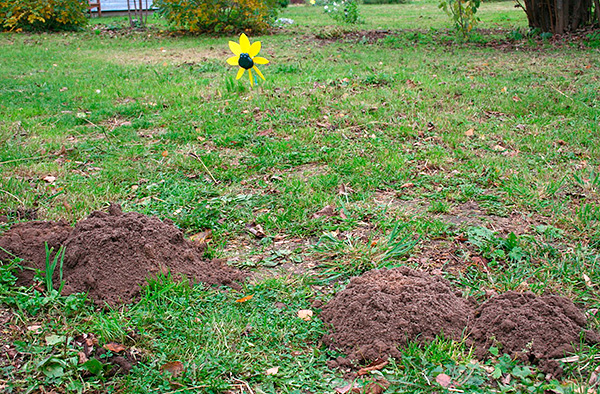
After catching all the moles, pit traps must be dug out of the ground so that various beneficial insects do not fall into them or die (as well as shrews that bring a lot of benefit to the garden, although many fight these animals unknowingly).
We catch moles with a shovel
This method of catching moles is as simple in principle as it is difficult to implement: a gardener with a bayonet spade waits near the mole's moves when the animal will pass through one of the galleries close to the earth's surface. At this moment, the earth rises slightly above it, and the movement of the animal is clearly visible. The task of the catcher is to stick a shovel bayonet behind the mole and, with a quick movement, throw the soil with the animal itself onto the surface of the earth.

The main difficulties of this method:
- Usually you have to spend a lot of time before you can notice the movement of the mole in its course. As a rule, moles inspect passages every few hours, but individual branches may not be visited for days on end. So there is no guarantee that a person on duty in a certain part of the garden will wait for the appearance of the animal;
- In addition, the mole needs to be dug up very quickly - the animal moves under the ground rather quickly, and can avoid the fate of being caught if the gardener shows sluggishness.
Nevertheless, the experience of a considerable number of gardeners shows that this method as a whole is quite effective and widespread: many moles catch a shovel.
Lethal means
Means that kill moles at the time of capture are available in various variations, and they implement different principles of action.
Note the most popular of them:
- Plunger trap - is installed above the mole, and the gatehouse is lowered into the course. When the animal passes along the gatehouse, the gatehouse descends and the brackets on the powerful spring crush the mole's body. After that, from a few seconds to several hours, the animal suffers, after which it dies;


- A harpoon trap (it is also sometimes referred to as a plunger type due to the design features) - is installed above the course, and when descending the gatehouse pushes several spoke harpoons. These harpoons pierce the animal, which, as in the previous case, often does not die immediately, but only after some time;


- Crushers - most often these are ordinary mousetraps and rat traps buried in passages, less often - special (and quite expensive) imported devices;

- Wire mole-catchers - kill a mole by squeezing his body (they can also be called strangleholds or a kind of ailing trap);


- Loops, which when triggered with force, are tightened on the body of the animal and lead to asphyxiation;

- And, finally, the so-called self-arrows (gunshot), usually of rather complex designs - they shoot the animal in the face.They are not available for sale and are made by hand, they require the use of gunpowder, shot and a motion sensor. Danger to people, and therefore their use is prohibited.

Any of these means allows you to catch a mole and immediately, on the spot, kill him without the direct participation of the owner of the site. As a rule, such devices are actively used by comrades who are not burdened with ideas about the need for a humane attitude to animals.
Here is a good example of using wire traps:
Is it worth catching moles with fishing hooks?
There is another livelihood way to catch a mole - catching it on a fishing hook. The principle is simple: a small hole is made in the arch of the course where a fishing line with several fishing hooks falls (tees are usually used for fidelity), the end of this fishing line is tied next to a metal pin driven into the ground or simply to a strong stick lying on the ground.
The mole, walking along its course, runs into a fishing hook and it hooks into the body, piercing the skin. The animal cannot be released, pulls on the fishing line, which is visible on the surface (sometimes a bell is attached to the pin, which at this moment starts to ring). After that, the gardener can only dig out the passage with a garden scoop and pull the resting mole to the surface right behind the fishing line.
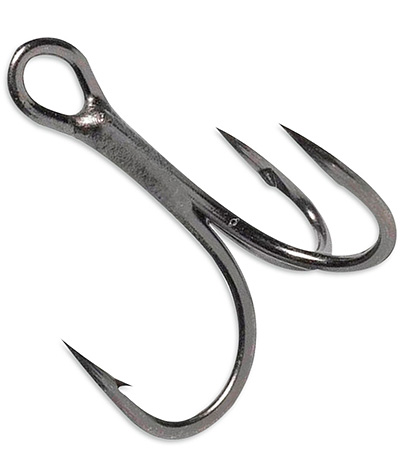
With such manipulations, the mole is sometimes literally torn along the side or abdomen with a hook. And it is clear that flayers using such a means of capture, will certainly not stand on ceremony with the animal after capture.
There is an even more sophisticated way of mocking a mole - to lower the same fishing hooks with earthworms previously planted on them. The animal will try to eat such a bait, and the hook will stick into his mouth or throat.
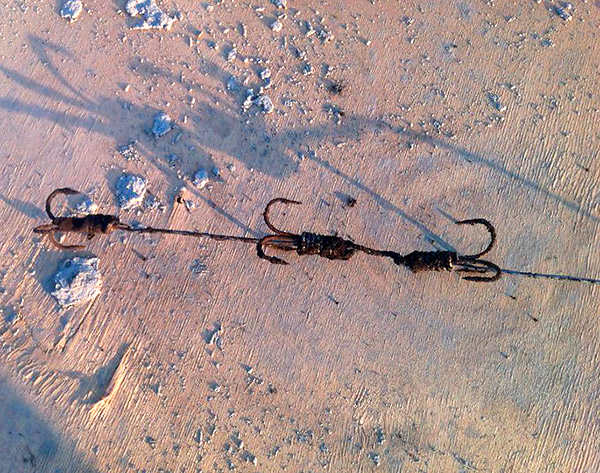
On a note
Perhaps somewhere here lies the line where animal abuse begins to border on sadism: if a simple gardener at the dacha is able to catch moles in such ways, then why are we surprised when somewhere in a foreign country a nose is sawed off by a grinder or skinning alive from foxes on fur farms.
We add here only that in terms of efficiency and laboriousness, catching a mole by a hook is comparable to using live traps. But if adequate gardeners are trying to save the life of the animal and not cripple it, then sadists, of course, will be more interesting to figure out how to catch a mole with gear from fishing hooks.
How to protect the site from re-penetration of moles
It should be understood that to catch a mole and remove it from the site - this does not mean at all to permanently protect your garden from these animals. If one mole somehow got into the territory, then in the future other individuals will be able to get here, it is only a matter of time.
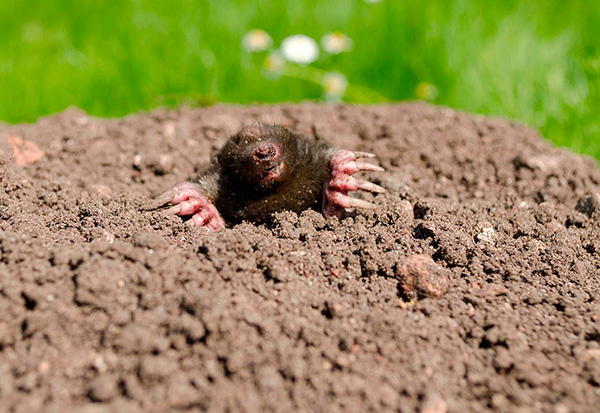
Therefore, even if it was possible to catch, it would seem, all moles in the garden, immediately after that it is useful to take measures to protect the site from them:
- On the perimeter, dig a plastic or metal mesh into the ground (to a depth of 70-80 cm and protruding above the ground by 15-20 cm). Sometimes a slate or roofing material is dug in instead of a mesh;
- A narrow, not very deep trench along the perimeter of the site also helps to protect against moles - it is covered with gravel or broken brick;
- A more expensive option is to pour a concrete foundation along the perimeter of the site with the subsequent installation of the fence;
- Laying in the area of the lawn net also helps - for this, the top layer of the lawn (5-10 cm) is removed, the net is laid, after which the top layer is laid back.
Such measures will ensure that moles on the site no longer appear.
If you have personal experience of catching moles in one way or another - be sure to share it by leaving a review at the bottom of this page. Perhaps this will help someone who is in the same situation.
An interesting video with an example of the use of a mole head pipe
And so they use wire molehills

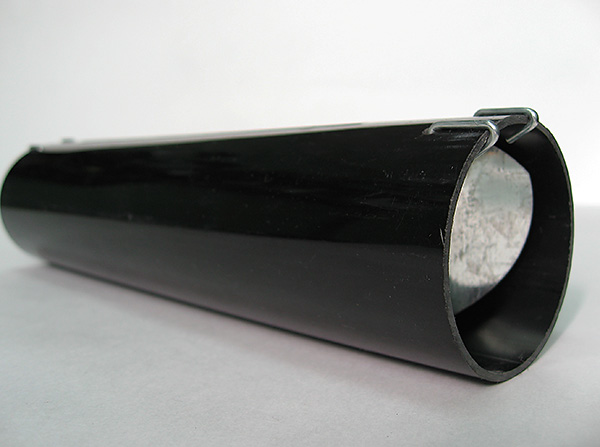
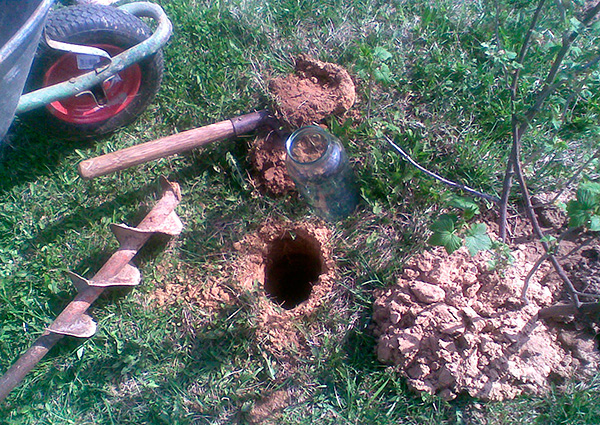
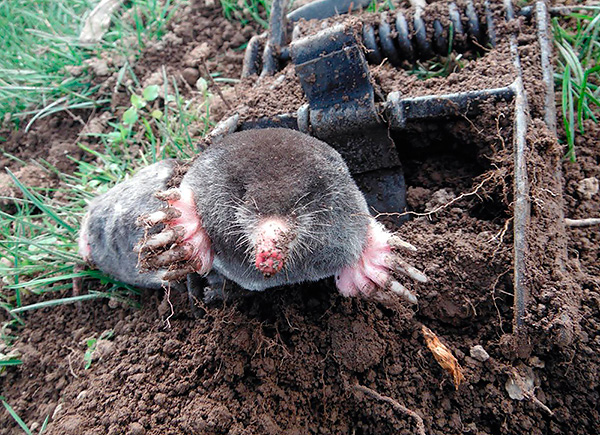
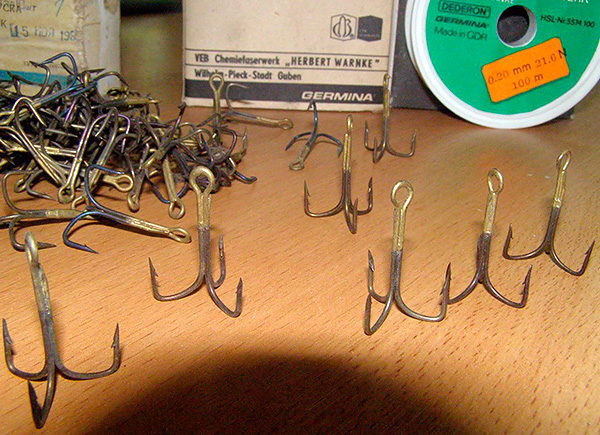
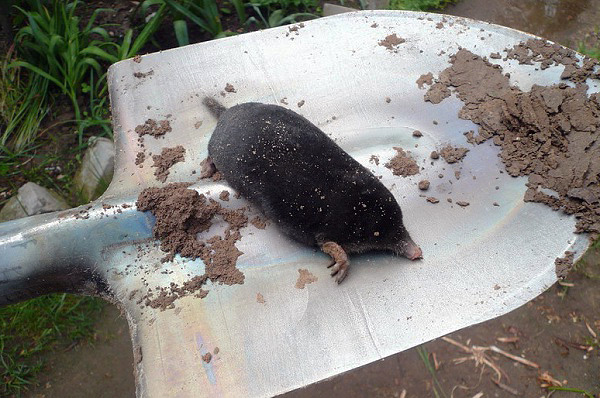
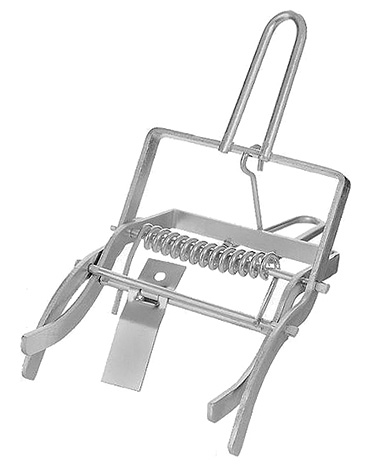
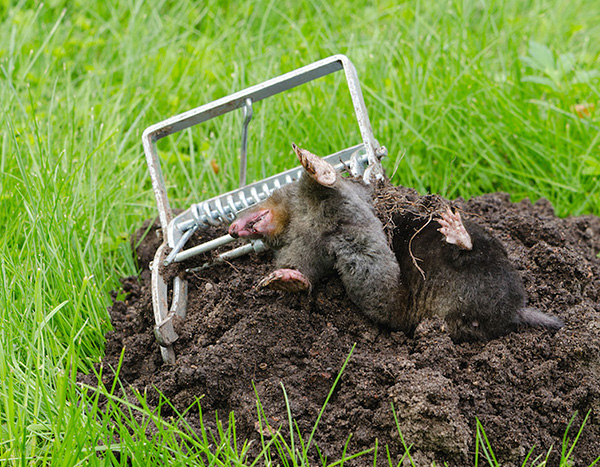
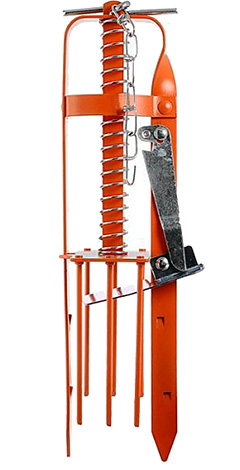
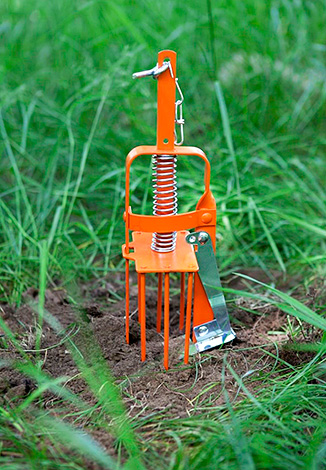
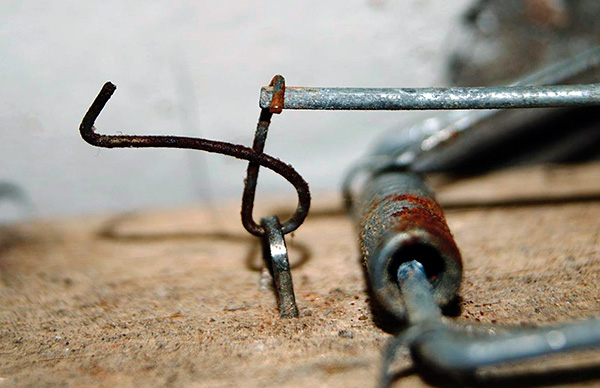
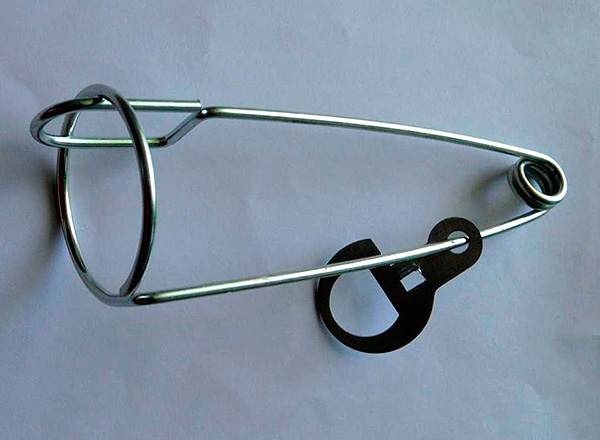
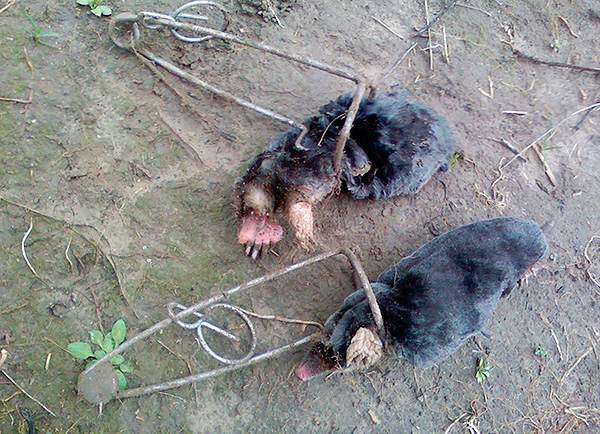
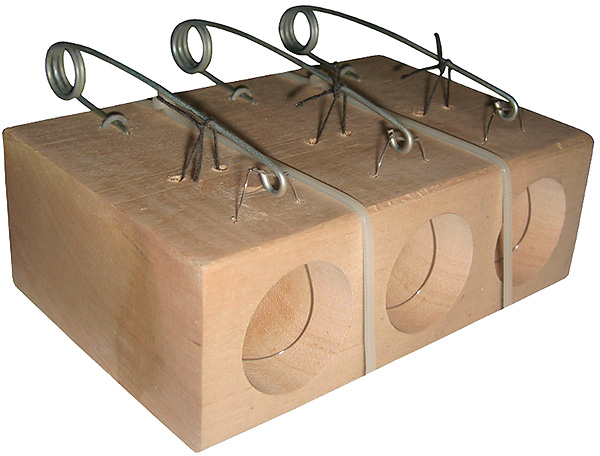
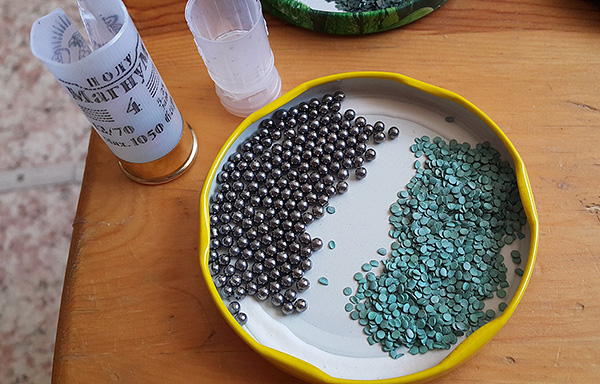



Thank you very much for your advice. Where can I buy a mole tube pipe in Ufa?
Over the summer, I caught 11 moles in a way with a can, but a significant difference - instead of a 3-liter can, I used plastic cans (preferably 2, 2.5 or 3 liters). I reached almost all the tips that are outlined in the article, I can say, by touch. If you take banks of a smaller denomination, then the moles simply jump out of them and bury them.
I want to note that moles learn very quickly, begin to clog traps with the earth, bury the pan, and tamp the wire traps. They drive an earthen jam in front of them.
Hello dear authors. I would like to clarify the desired diameter of the mole head tube. In the articles you indicated 9-12 cm, although in the photographs on the manufacture and drawings of pipes with a diameter of about 5-6 cm. And the mole does not pull in size on the sewer pipe-weaving)) So far I use pipes of 75 and 65 mm wide, but to no avail. Several rats were caught, and the mole clogs the pipe with earth, but does not climb into the middle.
After reading all the options, I made some conclusions for myself. Krotolovka-bank (bucket) is ineffective, as moles simply bury capacities with the earth ... Further, mole-traps by the type of mousetraps - they generally reach 10% in efficiency in my opinion. Moles just pull a mole catcher to the surface of the earth. They push the earth in front of them, the moleholes trigger, and the mole easily, without getting caught, tears it to the surface. I will test other options, thank you all.
Good day, dear friends. For about a month I caught moles in five different ways and mole traps ... 5 types of traps were installed on my site and in the end I killed 3 moles. In the end, what I want to tell you. All methods of catching moles are good, just the chance to catch a mole is 50% / 50%. If you did not catch a mole on the 1st day, then you should give up and despair. Just keep checking, fixing and setting new traps every morning. And most importantly - traps should be in every pile of land, or in a tunnel that leads to the surface where the mole pulls the ground. Not only that - ALL TRAPS SHOULD DIFFER FRIEND FROM ANOTHER! The mole grows smarter with each trap installed, and if at least 4-5 different types of traps stand on the site, sooner or later it will be mistaken, and you will catch a small pest ... I hope my advice will help everyone. Good luck friends! )